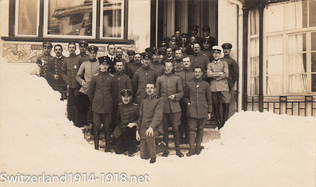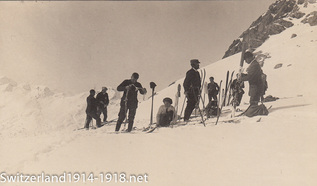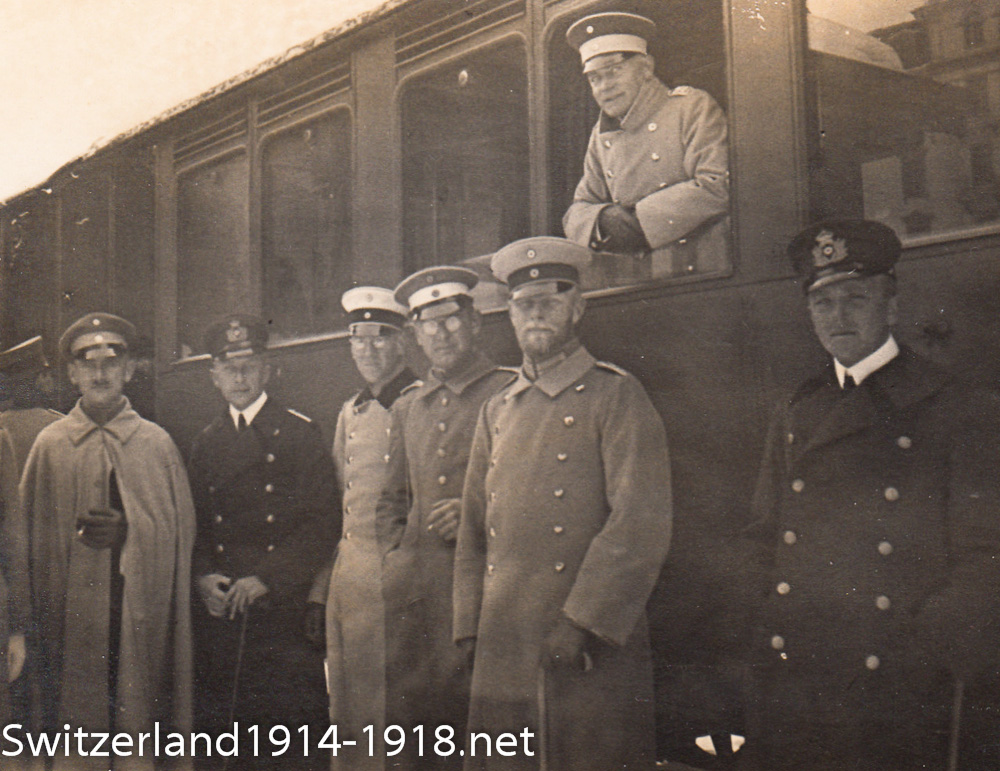Nick Bawden has kindly sent me copies of some interesting photographic postcards from his collection. Fortunately the postcards all have handwritten captions on the backs, which provide some useful information - although the writing took some deciphering!
(Photographs courtesy of Nick Bawden.)
(Photographs courtesy of Nick Bawden.)
The postcards all appear to show German internees at Davos in Switzerland. Davos is a town in the far east of Switzerland. Situated at a height of 1,560m, it is a popular area for cross-country skiing. Today it is probably most widely known as the location for the meetings of the World Economic Forum.
As I describe elsewhere on this website, personnel from both the Allies and the Central Powers were interned in Switzerland. Those chosen were prisoners of war who, though sick or badly wounded, might still be capable of military work and could therefore make fit soldiers available for serving at the frontline if they were repatriated. Internment in Switzerland would aid their recovery without furthering the enemy’s war effort. The photograph above shows German officers at Davos railway station, probably just after arriving there on their way to the internment camp. As you can tell from their headgear, they came from a variety of army units, as well as from the Imperial German Navy.
As I describe elsewhere on this website, personnel from both the Allies and the Central Powers were interned in Switzerland. Those chosen were prisoners of war who, though sick or badly wounded, might still be capable of military work and could therefore make fit soldiers available for serving at the frontline if they were repatriated. Internment in Switzerland would aid their recovery without furthering the enemy’s war effort. The photograph above shows German officers at Davos railway station, probably just after arriving there on their way to the internment camp. As you can tell from their headgear, they came from a variety of army units, as well as from the Imperial German Navy.

Left: His Royal Highness Prince Johann George of Saxony (on far right, in civilian clothes with walking stick), reviewing German officers at Davos internment camp. His visit was dated 17-19 January 1917.
Saxony is a German state, which includes the cities of Leipzig and Dresden. Prince Johann George was the younger brother of the then king of Saxony, who chose to abdicate at the end of the First World War.
Saxony is a German state, which includes the cities of Leipzig and Dresden. Prince Johann George was the younger brother of the then king of Saxony, who chose to abdicate at the end of the First World War.

Left: Prince Johann George of Saxony reviewing other ranks at the camp. By the snow on the ground and the thick overcoats that the men are wearing, you get a sense of how cold it must have been!

Left: German internees giving Christmas presents to fifteen orphans at Davos' New Sanatorium, 1916.
Although it was not all fun and games, being an internee was not the same as being a prisoner of war. Internees were often permitted to engage with local Swiss population.
Although it was not all fun and games, being an internee was not the same as being a prisoner of war. Internees were often permitted to engage with local Swiss population.

Left: The caption for this image is "On the day of departure of Herr Major Abt." It shows a group of German officers infront of a building, surrounded by deep snow.
It isn't completely clear what is happening here, but if I had to make an educated guess I would say that Major Abt was being repatriated to Germany because it was judged that his recovery from wounds (or mental strain) would take so long that he could not be employed for military purposes. The building behind the men might even be the one in which the internees lived.
It isn't completely clear what is happening here, but if I had to make an educated guess I would say that Major Abt was being repatriated to Germany because it was judged that his recovery from wounds (or mental strain) would take so long that he could not be employed for military purposes. The building behind the men might even be the one in which the internees lived.

Left: "lunchtime break at the Furka Pass (2445m).” It is not obvious that any of these were Germans, so perhaps they were Swiss from Davos who had been involved with the German internees.
Furka Pass is a high mountain pass in south-central Switzerland, a considerable distance away from Davos.
Furka Pass is a high mountain pass in south-central Switzerland, a considerable distance away from Davos.
Thank you again to Nick Bawden for sending me these photographs (I have marked the photographs with my website's address, but the rights to the photographs belong to him). Thanks also to my mother for checking my efforts at translating the captions! I would be interesting in any further comments on the photographs.

 RSS Feed
RSS Feed
